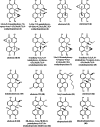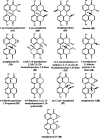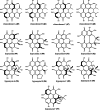Fungal perylenequinones
- PMID: 35401071
- PMCID: PMC8977438
- DOI: 10.1007/s11557-022-01790-4
Fungal perylenequinones
Abstract
Perylenequinones (PQs) are aromatic polyketides with an oxidized pentacyclic core that make up a family of natural compounds. Naturally occurring PQs mostly are produced by phytopathogenic fungi, with few aphides, crinoids, and plants. PQs, also known as photosensitizers, absorb light energy which empowers them to produce reactive oxygen species that damage host cells. Therefore, PQs gained a considerable interest in pharmaceutical application notably in photodynamic therapy. This review presents a comprehensive overview of fungal PQs. Their occurrence, categorization, biosynthesis, structures, and bioactivities are all discussed in detail. After that, an analysis outlines their distribution across the kingdom of fungi. A total of 66 fungal PQs have been described from 22 ascomycete genera (Alternaria, Aspergillus, Bulgaria, Cenococcum, Cercospora, Cladosporium, Curvularia, Daldinia, Elsinoë, Hypocrella, Hypomyces, Parastagonospora, Phaeosphaeria, Phylacia, Pyrenochaeta, Rhopalostroma, Rubroshiraia, Setophoma, Shiraia, Stemphylium, Stagonospora, and Thamnomyces). Dothideomycetes account for the majority of documented fungal PQs (82%), followed by Sordariomycetes (14%), Leotiomycetes (3%), and Eurotiomycetes (1%). Herein, five families Pleosporaceae, Phaeosphaeriaceae, Cladosporiaceae, Shiraiaceae, and Hypoxylaceae are highlighted as potential sources of novel PQs due to their diversity. The review intends to pique bioprospectors' interest in fungal PQs. Indeed, the pharmaceutical and agrochemical industries might gain greatly by exploiting fungal perylenequinones. Graphical abstract.
Keywords: Dothideomycetes; Fungal natural products; Perylenequinones; Photodynamic therapy; Sordariomycetes.
© German Mycological Society and Springer-Verlag GmbH Germany, part of Springer Nature 2022.
Conflict of interest statement
Conflict of interestThe authors declare no competing interests.
Figures













References
-
- Ahonsi MO, Maurhofer M, Boss D, Défago G. Relationship between aggressiveness of Stagonospora sp. isolates on field and hedge bindweeds, and in vitro production of fungal metabolites cercosporin, elsinochrome A and leptosphaerodione. Eur J Plant Pathol. 2005;111:203–215. doi: 10.1007/s10658-004-2878-5. - DOI
-
- Anderson JM, Murray J (1956) lsolation of 4,9-dihytlroxy-peryecne-3,10-quinone from a fungus. Chem Ind 376–376
-
- Arnone A, Assante G, Di Modugno V, et al. Perylenequinones from cucumber seedlings infected with Cladosporium cucumerinum. Phytochemistry. 1988;27:1675–1678. doi: 10.1016/0031-9422(88)80424-2. - DOI
Publication types
LinkOut - more resources
Full Text Sources
Miscellaneous
